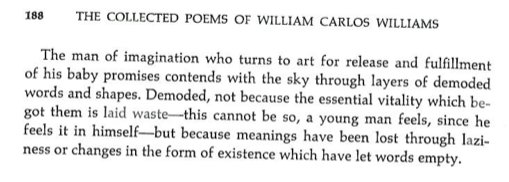Option 1 — Do a close reading of the following passage from William Carlos Williams’ Spring and All (1923). (By close reading, I mean focus in on particular words and phrases and the way they build a symbolic pattern that supports the writer’s argument.) Quote one of the readings for this week (Tichi or Jones, for example) to explain how Williams conceives imagination and poetic composition in gendered ways, related to waste, efficiency, and flow.

Option 2 — Compare the two versions of modernity presented this week: the earlier European versus the later American version. How are economy, waste, and artistic composition figured differently by Baudelaire and William Carlos Williams (or some other modern American artist-figure from the 1920-30s)? What does waste represent in each context, and is it more or less valued in the European or American context? Use quotes from at least one of the readings to support your argument.


